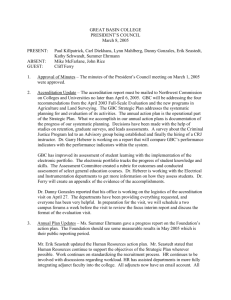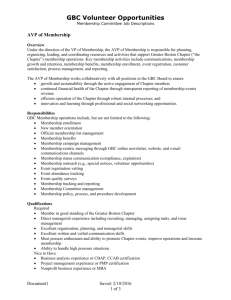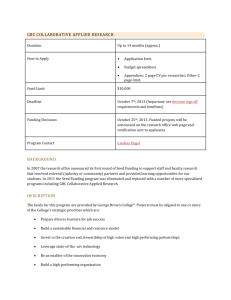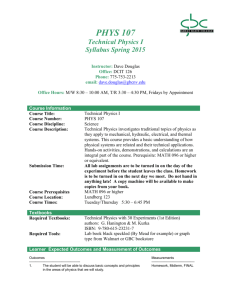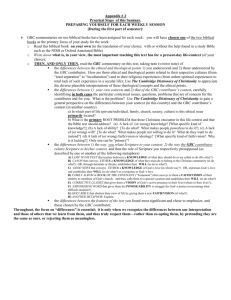Schedule
advertisement
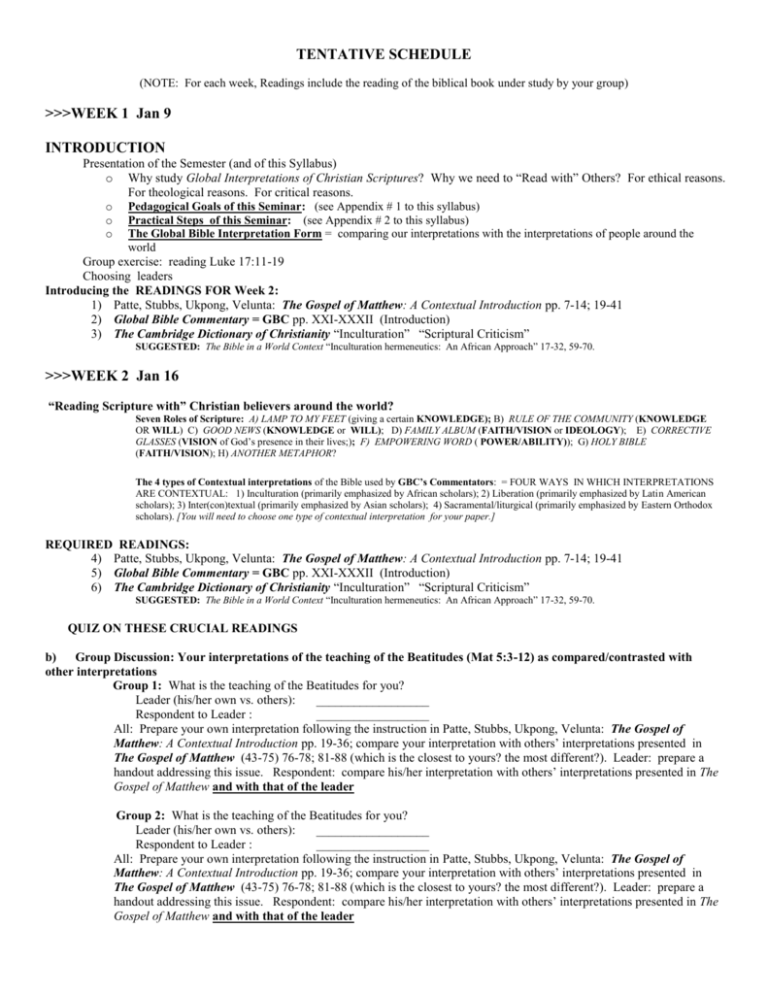
TENTATIVE SCHEDULE (NOTE: For each week, Readings include the reading of the biblical book under study by your group) >>>WEEK 1 Jan 9 INTRODUCTION Presentation of the Semester (and of this Syllabus) o Why study Global Interpretations of Christian Scriptures? Why we need to “Read with” Others? For ethical reasons. For theological reasons. For critical reasons. o Pedagogical Goals of this Seminar: (see Appendix # 1 to this syllabus) o Practical Steps of this Seminar: (see Appendix # 2 to this syllabus) o The Global Bible Interpretation Form = comparing our interpretations with the interpretations of people around the world Group exercise: reading Luke 17:11-19 Choosing leaders Introducing the READINGS FOR Week 2: 1) Patte, Stubbs, Ukpong, Velunta: The Gospel of Matthew: A Contextual Introduction pp. 7-14; 19-41 2) Global Bible Commentary = GBC pp. XXI-XXXII (Introduction) 3) The Cambridge Dictionary of Christianity “Inculturation” “Scriptural Criticism” SUGGESTED: The Bible in a World Context “Inculturation hermeneutics: An African Approach” 17-32, 59-70. >>>WEEK 2 Jan 16 “Reading Scripture with” Christian believers around the world? Seven Roles of Scripture: A) LAMP TO MY FEET (giving a certain KNOWLEDGE); B) RULE OF THE COMMUNITY (KNOWLEDGE OR WILL) C) GOOD NEWS (KNOWLEDGE or WILL); D) FAMILY ALBUM (FAITH/VISION or IDEOLOGY); E) CORRECTIVE GLASSES (VISION of God’s presence in their lives;); F) EMPOWERING WORD ( POWER/ABILITY)); G) HOLY BIBLE (FAITH/VISION); H) ANOTHER METAPHOR? The 4 types of Contextual interpretations of the Bible used by GBC’s Commentators: = FOUR WAYS IN WHICH INTERPRETATIONS ARE CONTEXTUAL: 1) Inculturation (primarily emphasized by African scholars); 2) Liberation (primarily emphasized by Latin American scholars); 3) Inter(con)textual (primarily emphasized by Asian scholars); 4) Sacramental/liturgical (primarily emphasized by Eastern Orthodox scholars). [You will need to choose one type of contextual interpretation for your paper.] REQUIRED READINGS: 4) Patte, Stubbs, Ukpong, Velunta: The Gospel of Matthew: A Contextual Introduction pp. 7-14; 19-41 5) Global Bible Commentary = GBC pp. XXI-XXXII (Introduction) 6) The Cambridge Dictionary of Christianity “Inculturation” “Scriptural Criticism” SUGGESTED: The Bible in a World Context “Inculturation hermeneutics: An African Approach” 17-32, 59-70. QUIZ ON THESE CRUCIAL READINGS b) Group Discussion: Your interpretations of the teaching of the Beatitudes (Mat 5:3-12) as compared/contrasted with other interpretations Group 1: What is the teaching of the Beatitudes for you? Leader (his/her own vs. others): __________________ Respondent to Leader : __________________ All: Prepare your own interpretation following the instruction in Patte, Stubbs, Ukpong, Velunta: The Gospel of Matthew: A Contextual Introduction pp. 19-36; compare your interpretation with others’ interpretations presented in The Gospel of Matthew (43-75) 76-78; 81-88 (which is the closest to yours? the most different?). Leader: prepare a handout addressing this issue. Respondent: compare his/her interpretation with others’ interpretations presented in The Gospel of Matthew and with that of the leader Group 2: What is the teaching of the Beatitudes for you? Leader (his/her own vs. others): __________________ Respondent to Leader : __________________ All: Prepare your own interpretation following the instruction in Patte, Stubbs, Ukpong, Velunta: The Gospel of Matthew: A Contextual Introduction pp. 19-36; compare your interpretation with others’ interpretations presented in The Gospel of Matthew (43-75) 76-78; 81-88 (which is the closest to yours? the most different?). Leader: prepare a handout addressing this issue. Respondent: compare his/her interpretation with others’ interpretations presented in The Gospel of Matthew and with that of the leader -2- >>>WEEK 3 Jan 23 a) “Reading Scripture with” Christian believers around the world? Review and how these apply to YOUR interpretation of the Gospel according to Luke and the letters to Colossians Seven Roles of Scripture – which one did you presuppose? which one was used by the authors of the GBC commentaries? The 4 types of Contextual interpretations of the Bible used by GBC’s Commentators: = FOUR WAYS IN WHICH INTERPRETATIONS ARE CONTEXTUAL: 1) Inculturation (primarily emphasized by African scholars); 2) Liberation (primarily emphasized by Latin American scholars); 3) Inter(con)textual (primarily emphasized by Asian scholars); 4) Sacramental/liturgical (primarily emphasized by Eastern Orthodox scholars). [You will need to choose one type of contextual interpretation for your paper.] Which one did you presupposed? Which one did you use when interpreting the biblical text for a specific context today (in so doing your chosen one)? Which one was used by the authors of the GBC commentaries? BEGINNING TO THINK ABOUT YOUR PAPER – WHICH STRATEGY WILL YOU USE? Every interpretation is contextual (although interpreters are rarely conscious of it): Preliminary presentation of 5 types of strategies for becoming self-conscious about the contextual character of biblical interpretations: 1) paying attention to the ways in which they “affect certain groups of people” (e.g., an aspect of feminist interpretations); 2) studying the history of reception (Wirkungsgeschichte) of biblical texts (early Jewish receptions; in the New Testament; and later through history up to today: “Reception/Scriptural Criticism,” primarily emphasized by Western European and North American scholars), 3) “reading with ordinary readers” (emphasized by 2/3 world scholars); 4) “breaking biblical texts” (using traditional ways of reading, particular to each culture); 5) “producing alternate contextual interpretations” (and in the process showing the contextual character of other interpretations). [You will need to choose one strategy for your paper.] Importance of accounting for the ways in which readers are positively or negatively affected by readings of Scripture. READINGS: 1) The Gospel of Matthew: A Contextual Introduction pp. 7-14; 19-41 2) Global Bible Commentary = GBC pp. XXI-XXXII 3) The Cambridge Dictionary of Christianity “Inculturation” “Scriptural Criticism” SUGGESTED: The Bible in a World Context “Inculturation hermeneutics: An African Approach” 17-32, 59-70. b) Group Discussion (two examples of Inculturation): Group 1: LUKE by Justin Ukpong (Nigeria); Presenter to entire class of GBC : __________________ Leader (his/her own vs. GBC): __________________ Respondent to Leader : __________________ Group 2: COLOSSIANS by Teresa Okure (Nigeria) Presenter to entire class of GBC : __________________ Leader (his/her own vs. GBC): __________________ Respondent to Leader : __________________ READINGS: Global Bible Commentary = GBC LUKE by Ukpong (Nigeria) Global Bible Commentary = GBC COLOSSIANS by Okure (Nigeria) The Cambridge Dictionary of Christianity Mission (several articles); Nigeria (Christianity in); c) Lecture: Classical Models for the Interpretation of Scriptures: Roles of Scripture in MUSLIM AND JEWISH INTERPRETATIONS: Islam and Qur’an ; Pharisees and Scripture, Midrash, Targum SUGGESTED: Wilfred Cantwell Smith, What is Scripture? A Comparative Approach. Pp. 1-44 (45-64); Scripture in Islam pp. 65-91; Scripture In Judaism, pp. 91-123 >>>WEEK 4 Jan 30 a) Contemporary Models for the Interpretation of Scriptures: “OPPRESSION” AND “LIBERATION HERMENEUTICS” READINGS: The Cambridge Dictionary of Christianity “Liberation Theologies” (multiple articles) “Oppression” SUGGESTED: The Bible In a World Context. pp. 3-15, 53-58. Elsa Tamez “Reading the Bible under a Sky without Star” and “A Star illuminates the darkness and Kwok Pui-lan, “Post-Colonial Studies and Feminist Biblical Interpretation” pp. 77-99 in PostColonial Imagination & Feminist Theology b) Group Discussion (two examples of liberation interpretation): THEME: What is the teaching of 1 Timothy or Exodus about “oppression” and “liberation”? -3Group 1: 1 TIMOTHY by Elsa Tamez (Costa Rica) Presenter of GBC : ___________________ Leader (his/her own vs. GBC): ___________________ Respondent to Leader : ___________________ READINGS: Bible: 1 Timothy GBC: 1 TIMOTHY by Elsa Tamez (Costa Rica) Cambridge Dictionary of Christianity “Pastoral Letters” “Costa Rica” Group 2: EXODUS by Jorge Pixley (Nicaragua) Presenter of GBC : ___________________ Leader (his/her own vs. GBC): ___________________ Respondent to Leader : ___________________ READINGS: Bible: Exodus GBC EXODUS by Jorge Pixley (Nicaragua) Cambridge Dictionary of Christianity “Exodus” “Nicaragua” c) Lecture: Classical Models for the Interpretation of Scriptures: APOCALYPTIC JUDAISM (QUMRAN) READINGS: The Cambridge Dictionary of Christianity “Qumran” “Dead Sea Scrolls” “Apocalypticism” SUGGESTED: Smith, What is Scripture? A Comparative Approach In Judaism, pp. 91-123 (review) >>>WEEK 5 Feb 6 a) Contemporary Models for the Interpretation of Scriptures: INTER(CON)TEXTUAL HERMENEUTICS READINGS: Kwok, Pui Lan. “Discovering the Bible in the Non-Biblical World: The Journey Continues.” Journal of Asian and Asian-American Theology 2 No 1 (Sum 1997): pp. 64-77. (see WEB Page) The Cambridge Dictionary of Christianity “Bible Interpretation Cluster” (multiple articles) SUGGESTED: Yeo Khiok-khng, Navigating Romans Through Cultures, pp. 1-20; 259-294. The Bible In a World Context pp. 3349, 71-75. b) Group Discussion Group 1: LAMENTATIONS by Archie Lee (China) Presenter of GBC : ___________________ Leader (his/her own vs. GBC): ___________________ Respondent to Leader : ___________________ READINGS: Bible: Lamentations GBC LAMENTATIONS by Archie Lee; The Cambridge Dictionary of Christianity “Lamentations” “Hong Kong” & “China” Theodicy; God, Christian Views of, Cluster; Evil, the Problem of; Suffering. Group 2: JOHN by Kyung-mi Park (Korea) Presenter of GBC : ___________________ Leader (his/her own vs. GBC): ___________________ Respondent to Leader : ___________________ READINGS: Bible: The Gospel of John GBC THE GOSPEL OF JOHN by Kyung-mi Park The Cambridge Dictionary of Christianity “John, Gospel of” “Korea” “Buddhism and Christianity” “Shamanism and Christianity” c) Lecture: Classical Models for the Interpretation of Scriptures: Early Christians Interpretations of Scriptures; by Paul, and Matthew. READINGS: The Cambridge Dictionary of Christianity “Bible Interpretation Cluster” (multiple articles) >>> Hopefully Sunday Feb. 10: Holy Trinity Greek Orthodox Church; attending the “The Divine Liturgy” (worship service) followed by a question/answer period with the Priest, Fr. Gregory Hohnholt at 10 AM (meeting at -49:30 AM) to about noon –in preparation of our discussion of Greek Orthodox interpretations of the Gospel of John and Hebrews Holy Trinity Greek Orthodox Church 4905 Franklin Pike Nashville, TN 37220 >>>>WEEK6 Feb 13 a) Contemporary Models for the Interpretation of Scriptures: SACRAMENTAL-LITURGICAL HERMENEUTICS READINGS: James Chukwuma Okoye, “Power and Worship: Revelation in Africa” pp. 110-126 in Rhoads, From Every People and Nation. On our web-page The Cambridge Dictionary of Christianity “Liturgies, History of” b) Group Discussions Group 1: JOHN Petros Vassiliadis (Greece) Presenter of GBC : ___________________ Leader (his/her own vs. GBC): ___________________ Respondent to Leader : ___________________ READINGS: Bible: The Gospel of John GBC JOHN (Petros Vassiliadis, Greece) The Cambridge Dictionary of Christianity “John, Gospel of” “Greece” Group 2: HEBREWS Stelian Tofanâ (Romania) Presenter of GBC : ___________________ Leader (his/her own vs. GBC): ___________________ Respondent to Leader : ___________________ READINGS: Bible: Hebrews (letter to the) GBC HEBREWS (Stelian Tofanâ, Romania) The Cambridge Dictionary of Christianity “Hebrews”; “ “Romania” c) Lecture: Classical Models for the Interpretation of Scriptures: PATRISTIC AND MIDDLE AGE SUGGESTED: The Cambridge Dictionary of Christianity Patristics; Patristic Thought; Patristic Thought in Orthodox Christianity. A Short History of the Interpretation of the Bible. pp. 39-91 >>>WEEK7 Feb 20 DUE Feb 19 noon *****CHOOSING A BIBLICAL BOOK as topic for your paper. You must have chosen a biblical book by Feb 19 noon (EMAILED with two ranked alternates) [[Any biblical book EXCEPT THOSE DISCUSSED IN CLASS in the first part of the Semester; or chosen by someone else]] a) Strategies for Becoming Self-Conscious about the Contextual Character of Biblical Interpretations: “READING WITH ORDINARY READERS” READINGS: GBC, Gerald West, pp. 96-99; Blount, “The Witness of Active Resistance: The Ethics of Revelation in African-American Perspective’ pp. 28-46, in Rhoads, From Every People and Nation The Cambridge Dictionary of Christianity Postcolonialism and Christian Theology SUGGESTED: The Academy of the Poor Gerald West or Vítor Westhelle, “Revelation 13: Between the Colonial and the Postcolonial, a Reading from Brazil” pp. 183-199 in Rhoads, From Every People and Nation . b) Group Discussions Group 1: 1- 2 SAMUEL Gerald West (Kwa-Zulu, S. Africa) Presenter of GBC : ___________________ Leader (his/her own vs. GBC): ___________________ Respondent to Leader : ___________________ READINGS: Bible: 1 & 2 Samuel GBC 1 and 2 SAMUEL Gerald West The Cambridge Dictionary of Christianity Samuel, 1 & 2; South Africa Group 2: EPHESIANS John Riches (Scotland, U.K.) Presenter of GBC : ___________________ Leader (his/her own vs. GBC): ___________________ Respondent to Leader : ___________________ -5READINGS: Bible: Ephesians GBC EPHESIANS John Riches The Cambridge Dictionary of Christianity Ephesians; United Kingdom c) Lecture: Classical Models for the Interpretation of Scriptures: Modern Ways of Reading the Bible; Historical Critical Biblical Studies: Example, “The Quest of the Historical Jesus” READINGS: GBC pp. 329-349. Jesus in Asian, African, Latin American, Orthodox, Western Perspectives. The Cambridge Dictionary of Christianity Jesus; Jesus, Images of, Cluster (multiple articles) SUGGESTED: Kwok, Pui-lan. “On Color-Coding Jesus,” pp. 176-188 in Sugirtharajahm ed. The Post-Colonial Bible. >>>WEEK 8 Feb 27 Due Feb 27: PAPER PROPOSAL a) Strategies for Becoming Self-Conscious about the Contextual Character of Biblical Interpretations: STUDYING THE HISTORY OF RECEPTION & SCRIPTURAL CRITICISM READINGS: The Cambridge Dictionary of Christianity Scriptural Criticism; Reception Studies of; SUGGESTED READINGS: Grenholm & Patte “Overture: Receptions, Critical Interpretations, and Scriptural Criticism” pp. 1-44 in Reading Israel in Romans b) Group Discussions Group 1: LEVITICUS Alan Cooper and Susan Scholz (USA and Germany) Presenter of GBC : ___________________ Leader (his/her own vs. GBC): ___________________ Respondent to Leader : ___________________ READINGS: Bible: Leviticus GBC LEVITICUS Alan Cooper and Susan Scholz The Cambridge Dictionary of Christianity Leviticus; Judaism and Christianity Cluster; Anti-Semitism; Supersessionism; and Germany Group 2: ROMANS Daniel Patte (USA and France) Presenter of GBC : ___________________ Leader (his/her own vs. GBC): ___________________ Respondent to Leader : ___________________ READINGS: Bible: Romans GBC ROMANS Daniel Patte The Cambridge Dictionary of Christianity Romans; Judaism and Christianity Cluster; Anti-Semitism; Supersessionism; and France b) Lecture: The topic of your paper **Spring BREAK *** >>>WEEK 9 March 13 a) Strategies for Becoming Self-Conscious about the Contextual Character of Biblical Interpretations: “BREAKING BIBLICAL TEXTS” and “PRODUCING ALTERNATE CONTEXTUAL INTERPRETATIONS” READINGS: GBC NUMBERS Jione Havea or EZRA-NEHEMIAH Donna Fewell SUGGESTED READINGS: Tina Pippin “The Heroine and the Whore: The Apocalypse of John in a Feminist Perspective” pp. 127-145, and Barbara Rossing, “For the Healing of the World; Reading Revelation Ecologically” pp. 165182 in Rhoads, From Every People and Nations. A Short History of the Interpretation of the Bible. Robert Grant and David Tracy, pp. 155-187 b) Group Discussions Group 1: NUMBERS Jione Havea (Pacific Islands) Presenter of GBC : ___________________ Leader (his/her own vs. GBC): ___________________ Respondent to Leader : ___________________ READINGS: Bible: Numbers GBC NUMBERS Jione Havea -6The Cambridge Dictionary of Christianity Numbers Papua New Guinea & History of Christianity in South Pacific; Group 2: EZRA-NEHEMIAH Donna Fewell (USA) Presenter of GBC : ___________________ Leader (his/her own vs. GBC): ___________________ Respondent to Leader : ___________________ READINGS: Bible: Ezra and Nehemiah GBC EZRA-NEHEMIAH Donna Fewell The Cambridge Dictionary of Christianity Ezra & Nehemiah; United States of America SECOND PART OF SEMESTER: DISCUSSION OF PAPERS-IN-THE-MAKING & corresponding readings in GBC & CDC >>>WEEK 10 March 20 Biblical books chosen by students for their papers and related readings in Global Bible Commentary and The Cambridge Dictionary of Christianity DISCUSSION OF PARTS 1-2 OF THE PAPERS OF THREE OF YOU… How does each compare with the corresponding GBC chapters? [with handout by presenters sent Thursday by e-mail] RESPONDENTS underscore the differences with the way the presenters teaching and the GBC teaching would apply to the problems and root problem of the contexts chosen for their own papers. Presenter: ___________________ Respondent: ___________________ Presenter: ___________________ Respondent: ___________________ Presenter: ___________________ Respondent: ___________________ >>>WEEK 11 March 27 Biblical books chosen by students for their papers and related readings in Global Bible Commentary and The Cambridge Dictionary of Christianity. DISCUSSION OF PARTS 1-2 OF THE PAPERS OF THREE OF YOU… [with handout by presenters sent Thursday by email]. Presenter: ___________________ Respondent: ___________________ Presenter: ___________________ Respondent: ___________________ Presenter: ___________________ Respondent: ___________________ >>>WEEK 12 April 3 Biblical books chosen by students for their papers and related readings in Global Bible Commentary and The Cambridge Dictionary of Christianity. DISCUSSION OF PARTS 1, 2 & 3 OF THE PAPERS OF THREE OF YOU… How does each compare with the corresponding GBC chapters? [with handout by presenters sent Thursday by e-mail]. Presenter: ___________________ Respondent: ___________________ Presenter: ___________________ Respondent: ___________________ Presenter: ___________________ Respondent: ___________________ >>>WEEK 13 April 10 Biblical books and related readings in Global Bible Commentary chosen by students for their papers. -7DISCUSSION OF PARTS 1, 2 & 3 OF THE PAPERS OF THREE OF YOU… How does each compare with the corresponding GBC chapters? [with handout by presenters sent Thursday by e-mail]. Presenter: ___________________ Respondent: ___________________ Presenter: ___________________ Respondent: ___________________ Presenter: ___________________ Respondent: ___________________ >>>WEEK 14 April 17 Biblical books chosen by students for their papers and related readings in Global Bible Commentary and The Cambridge Dictionary of Christianity. DISCUSSION OF PARTS 1- 4 OF THE PAPERS OF THREE OF YOU… How does each compare with the corresponding GBC chapters? [with handout by presenters sent Thursday by e-mail]. Presenter: ___________________ Respondent: ___________________ Presenter: ___________________ Respondent: ___________________ Presenter: ___________________ Respondent: ___________________ PAPER DUE Saturday April 28 at 3:00 PM by e-mail -8- Appendix # 1 Pedagogical Goals of this Seminar: The goal of this seminar on “Global Interpretations of Christian Scriptures” is to help its members: A. To learn about distinctive interpretations of the Bible as Christian Scriptures around the world. Why? a) Because most of the readers of the Bible are Christian believers who read this text as SCRIPTURE—a fact that one cannot afford to bracket-out be it in religious studies, critical studies of the Bible, or in theology; b) because 2/3 of Christian readers of the Bible are in Africa, Asia, Latin America, and Oceania, as well as in Eastern Europe and the Middle East (Orthodox Christians), and 1/3 in Western Europe and North America (Catholics and Protestants). B. To gain a solid understanding of: 1) What is involved in any “interpretation of Scriptures.” How it is related to: a) the interpreters’ view of what is most significant in the biblical text. [Analytical Choices] b) the believers’ vision of life, structured by religious experience and culture; [Hermeneutical, Theological Choices] c) their concerns and commitments in the concrete social, economic, political reality of their life-context, and thus to their “ideology”; [Contextual Choices] 2) What is involved in “interpretations of Christian Scriptures,” i.e., both in the interpretation of the Scriptures that are exclusively Christian (the New Testament) as well as the Christian interpretations of the Jewish Scriptures (Tanakh or Hebrew Bible). What distinguish these Christian interpretations? i. A certain Christian vision of life? Christian religious experience? A particular way in which this vision of life is related to the believers’ given cultures? [Hermeneutical, Theological Choices = H choices] ii. A certain conception of the believers’ relationship to their life-context? of the believers’ relationship to power and authority? of the believers’ sense of responsibility for those in need, in their family, their Christian community, their society, and/or in the international context? [Contextual Choices = C choices] iii. A certain view of what is most significant in the biblical texts? Its “narrative” (e.g., because believers view it as their story)? Its moral teaching (e.g., because it aims to transform its readers’ behavior)? Its symbolism (e.g., because it contributes to establish the believers’ view of life)? Its rhetorical dimension (e.g., because it aims to transform its readers’ vision of life and behavior)? [Analytical Choice = A choices] 3) The diversified nature of “Global interpretations of Christian Scriptures.” Because interpretations performed in different parts of the world are “foreign” to us, they help us recognize, in our own and in (Western) scholarly interpretations the role of: a) the believers’ vision of life; [[H choices]]; b) the believers’ concerns and commitments in the concrete reality of their life-context [[C choices]] and c) their view of what is most significant in the biblical text. [[A choices]] C. To recognize that Christian believers and scholars are always making a choice among several possibilities of relating the teaching of the Bible: a) to their cultures (from “total separation” to “inculturation”) and their religious experiences (from ardent spiritual experiences to total lack of such experience in a secular life); [[H choices]] b) to their life contexts (from concerns for the needs of people every where to concerns exclusively limited to people close to us). [[C choices]] c) and this, by choosing as most significant one or another aspect of each Biblical text. [[A choices]] always very much concerned to assess the relative value of the teachings of the Bible resulting from each interpretation, as they try to discern (with religious discernment) those which are beneficial and those which are destructive in their context. As 2 Peter 3:15-17 warns regarding the interpretation of Paul: “ So also our beloved brother Paul wrote to you according to the wisdom given him, 16 speaking of this as he does in all his letters. There are some things in them hard to understand, which the ignorant and unstable twist to their own destruction, as they do the other scriptures. 17 You therefore, beloved, since you are forewarned, beware that you are not carried away with the error of the lawless and lose your own stability.” NRSV -9Appendix # 2 Practical Steps of this Seminar, PREPARING YOURSELF FOR EACH WEEKLY SESSION (1rst part of semester) GBC commentaries on two biblical books have been assigned for each week: you will have chosen one of the two biblical books as the primary focus of your study for the week o Read this biblical book on your own (in the translation of your choice; with or without the help found in a study Bible such as the NISB or Oxford Annotated Bible) o Write down what is, in your view, the most important teaching this text has for a present-day life-context (of your choice); o THEN, AND ONLY THEN, read the GBC commentary on this text, taking notes (written notes) regarding the differences between the ethical and theological points 1) you underscored and 2) those underscored by the GBC contributor; How are these ethical and theological points related to their respective cultures (from “total separation” to “inculturation”) and to their religious experiences (from ardent spiritual experiences to total lack of such experience in a secular life); Use The Cambridge Dictionary of Christianity to appreciate the diverse plausible interpretations of these theological concepts and the ethical points. the differences between 1) your own contexts and 2) that of the GBC contributor’s context, carefully identifying in both cases the particular contextual issues, questions, problems that are of concern for the contributor and for you; What is the problem? Use The Cambridge Dictionary of Christianity to gain a general perspective on the differences between your context (in this country) and the GBC contributor’s context (in another country). a) In which part of life (private/individual, family, church, society, culture) is this ethical issue primarily located? b) What is the primary ROOT PROBLEM that these Christians encounter in this life context and that the Bible text should address? (a) A lack of (or wrong) knowledge? [What specific kind of knowledge?]; (b) A lack of ability? [To do what? What makes people powerless to do it?] (c) A lack of (or wrong) will? [To do what? What makes people not willing to do it? What do they want to do instead?] (d) A lack of (or wrong) faith/vision or ideology? [What specific kind of faith/vision? Why is it lacking?] Only one can be “primary”! the differences between 1) the way you relate Scripture to your context; 2) the way the GBC contributor relates Scripture to his/her context, and thus the role of Scripture you respectively presupposed (as described by one or another of the following metaphors) A) LAMP TO MY FEET that teaches believers a KNOWLEDGE of what they should do or are called to do (Do what?) B) CANON that conveys EITHER a KNOWLEDGE of what they must do to belong to the Christian community (to do what?) OR, through demands or threats, establishes their WILL (to do to what?). C) GOOD NEWS that conveys EITHER a KNOWLEDGE of God’s love (in which way?) OR, expresses God’s love and establishes their WILL (to do what?) as a response to God=s love. D) FAMILY ALBUM or BOOK OF THE COVENANT (“Testament”) that conveys to them a FAITH/VISION of their identity as members of God’s family or a new IDEOLOGY and thus, calls them to a special vocation. E) CORRECTIVE GLASSES that gives them a VISION of God’s active presence in their lives (where in their lives?) And therefore challenges/corrects their current (wrong) IDEOLOGY or FAITH; F) EMPOWERING WORD that gives them the POWER/ABILITY to struggle for God’s justice (overcoming what difficult situation?). G) HOLY BIBLE that shatters their view of life and of faith by giving them a new FAITH/VISION (of what?). H) ANOTHER METAPHOR: Explain. the differences between the features of the text you found most significant and chose to emphasize, and those chosen by the GBC contributor; Throughout, the focus on “DIFFERENCES” is essential; it is only when we recognize the differences between our interpretation and those of others that we learn from them, and thus truly respect them—rather than co-opting them, by pretending they are the same as ours, or rejecting them as meaningless. GROUP DISCUSSION During the Group Discussion, one member of the group— Presenter of GBC -- will analyze and present the main characteristics (contextual, theological, textual characteristics) of the GBC interpretation of a text; another member of the group – the Discussion Leader – will present the contextual, theological, textual differences between his/her own contextual interpretation and that of the GBC. The Respondent to the Leader will present from the perspective of the context chosen for her/his paper a critical assessment of the leader’s handout: Contextual choices: Does the leader’s view of the problem and rootproblem in his/her chosen context make sense? Or would an alternate view be better or be more realistic? Hermeneutical/theological choices: Is the leader’s view of the role of scripture consistent with his/her assessment of the problem? What view of the role of scripture would be necessary if one has an alternate view of the problem? What theological or ethical issue or concept is central, and how is it defined? What are other possibilities? Analytical/Textual choices: What are the passages of the biblical book that the leader has chosen as most significant? Are there other passages which could have been even more significant with other contextual and theological choices? DURING THE SECOND PART OF THE SEMESTER The group discussions will be focused on biblical texts you will have chosen as topics for your papers; in several stages, you will prepare your own contextual commentary of this biblical text, formulating its teaching for a particular aspect of your own life-context following one of the patterns found in the GBC. - 10 - Appendix # 3 PAPER PROPOSAL DUE FEB 27 in class Choosing a Biblical Book as topic for your paper: your first choice and two alternates due (by email) Paper Proposal = 10 % due Feb 27. A paper prepared over the second part of the semester (including oral presentation with hand-out of a part of your paper): 30 % Final PAPER DUE April 29 9AM By Feb 19 noon you should have proposed your top three choices of a Biblical text [ranked in order of preference] among the biblical books which are NOT discussed during the first half of the semester. (You will know by February 20 at 3PM which of your three choices has been assigned to you.). 1) Paper Prososal Due FEB 27 3-4 pages paper proposal = 10% of Final Grade Your proposal should include the different parts of the form we use since the beginning of the semester, but the proposal should be in the style of a paper – with subtitles reflecting the content of the different parts of the form. (See also the syllabus and the PowerPoint. But the instructions here are more detailed and are the norm.) INTRODUCTION: (= Part A1 15%) Specify from which concrete life-context you propose to read the chosen book- explaining what is, for you, the overall/major problem for Christian believers today and how it finds a specific expression in this concrete life-context… As you will do in a more detailed fashion the first part of your paper. Then explain: Part A 2 5%) which Verses or passages of the Biblical text will be particularly helpful to address this problem (you will develop this below in C) Part A 3 10%) which THEME (or issue) is at the center of this problem and of these passages of the biblical text. What is your view/understanding of this THEME (as contrasted with other understandings of it; see CDC) Part B) ANALYZING THE PROBLEM Christian Believers need to address IN THIS CONCRETE LIFE- CONTEXT B1 10%) PRESENT AND ARGUE WHAT IS the Primary aspect of the believers’ life where this problem is (and why not the others) • A) private life? B) family-life? C) Christian community? D) society? E) culture (with its vision of life, values, ideologies)? F) relationship with people with different religious convictions? Then explain/argue which one of the four contextual ways of interpreting you will use: 1) in a cultural/way of life context (Inculturation)? 2) in a social, economic, or political context where people are oppressed or deprived (Liberation)? 3) in a literary/communication [media] cultural context with its texts and other cultural artifacts, and media (Inter(con)textual)? 4) in a religious context with its religious experiences and rituals (Sacramental/liturgical)? Why not the others? You need to show an indepth understanding of the difference between these contextual ways. Review your notes on the lectures and class discussion. B2 10%) PRESENT AND ARGUE WHAT IS the primary root-problem to be addressed (What kind? To do what? Explain why not the others?) A lack of (or wrong) A) KNOWLEDGE? B) ABILITY? C) WILL? D) FAITH/VISION or IDEOLOGY? B3 15%) PRESENT AND ARGUE WHAT IS THE ROLE OF SCRIPTURE that needs to be used to formulate the teaching to will truly address this root-problem? Which one? Why not the other ones? Are you sure the proposed role of scripture will truly contribute to address the above problem? A) LAMP TO MY FEET (giving a certain KNOWLEDGE); B) RULE OF THE COMMUNITY (KNOWLEDGE OR WILL) C) GOOD NEWS (KNOWLEDGE or WILL); D) FAMILY ALBUM (FAITH/VISION or IDEOLOGY); E) CORRECTIVE GLASSES (VISION of God’s presence in their lives;; IDEOLOGY) F) EMPOWERING WORD ( POWER/ABILITY)); G) HOLY BIBLE (FAITH/VISION); H) ANOTHER METAPHOR? Which one of the traditional interpretations of Scripture your interpretation is the closest to yours? The Pharisees and early rabbis? Apocalyptic Jews? Matthew? Paul? Why not the others? None of these? Explain. You need to show a clear understanding of the differences among these traditional interpretations of Scripture PART C 25%) Preliminary Analysis of your Text: an Overall Presentation of the Biblical Book, so as to identify and locate in it the specific passages and textual features that will be discussed in detail in your paper because, in your interpretation, they address the problem and root problem in the concrete life context you have chosen. (Use scholarly sources presenting an - 11 overview of your biblical book: e.g., in Div library reading room, the article on your biblical book in the ANCHOR BIBLE DICTIONARY or in THE INTERNATIONAL BIBLE COMMENTARY or in the NEW INTERPRETERS DICTIONARY OF THE BIBLE IN CONCLUSION (10%), explain what you expect will be the teaching of your biblical book for your chosen context – that is, how do you expect this teaching will resolve the problem and root problem in the concrete life of believers in this context. Then tentatively explain which of the five strategies you will use to become aware of your interpretive choices and their implications: 1) Paying attention to the ways in which they “affect certain groups of people” (e.g., an aspect of feminist interpretations)? 2) Studying the history of reception of biblical texts? 3) “Reading with ordinary readers”? 4) “Breaking biblical texts” (using traditional ways of reading, particular to each culture)? 5) “Producing alternate contextual interpretations” (challenging existing interpretation)? (Since we have not yet dealt with several of these, this section will be tentative.) TOPIC OF YOUR PAPER PAPER DUE APRIL 24 2013 9AM Prepare a “contextual interpretation” (a contextual commentary) of a book of the Bible of your choice (the body of your paper). Compare it with the interpretation found in the GBC, emphasize the differences so as to further show what is most distinctive in your interpretation and how thoroughly it is inculturated and contextualized. Prepare your 15-18 double-spaced page paper in 3 parts + a conclusion, after CHOOSING A BIBLICAL BOOK (in consultation with the instructor: you must have chosen a biblical book by Monday FEBRUARY 20 10 AM.) -PART I- YOUR LIFE CONTEXT , THE GBC LIFE CONTEXT, AND THE TEXT (30%) a) Introduction: Identifying the Life-Context in which the Biblical Book Is Interpreted. Your concrete presentation of the context from which you write. This sketch underscores those features of your situation which are related to the "contextual questions" that will be raised (see below, b). These features will be geographical, and also religious, cultural, political, economic, and/or social. This is either a "I" discourse, but more likely a "we, in this context" discourse. Him How does your life-context compare with (differ from) the life context of the GBC commentary on the same book? b) Analyzing the Life Context, its Problems and the Theological Issues it Raises Regarding the Relationship between the People of God and World. The Contextual and Theological Questions that focus 1) your reading of the biblical book and 2) the GBC reading of the book. This involves identifying in each case how “the people of God” is defined and how “the world” is defined, then to proceed to a two-way preliminary analysis of this present-day context in terms of the text and of the text in terms of the present-day context. This involves in each case: 1) pointing out those specific problems and issues regarding the relationship between the people of God and the world in that context which is highlighted by the text; and 2) identifying the specific passages of the text which are most significant in view of the context and the issues it raises. 1) Considering this life-context from the perspective of the given biblical book as corrective lenses, one can ask: What are the problems or needs concerning the relationship between the people of God and the world that the People of God should address in this situation for the sake of the world? For the sake of the people of God and its members? For instance: Are these needs related to the religious make up of the society, and concerns the relationship of the people of God to other religions or to a non-religious, secular majority? Are these cultural needs concerning the world view and the life-style of people in that context? Educational needs? Social needs concerning justice in this society and its structures of power and authority? Economic needs (regarding poverty, economic oppression, lack of healthcare)? Political needs calling for the confrontation of a corrupt political power? 2) Conversely, considering the given biblical book from the perspective of this life-context you also need to ask: What does this biblical book say regarding the relationship of the People of God to the world in this specific context in which the commentator is? Does it concern a mission of the People of God toward the world (toward individuals and communities beyond its borders)? If so, what kind of mission? Or, alternately, does it concern the active place and role of the People of God in society and culture (from which it may not really be regarded as separated)? Does the biblical book address the relationship of the people of God with political, economic, and social institutions and authorities? What does it say or imply about interactions with other religions? What are the other concrete or theological issues concerning the People of God in its relationship to the world? Most biblical books will contain material addressing many of these issues. You must therefore choose one (or a very few) of these issues, because it is particularly important in your present context. Is this an issue: Concerning the relationship between Christian and cultural identity (best addressed with an inculturation approach)? Concerning social and justice problems (best addressed with a liberation approach)? Concerning the relationship between Christians and other religions or groups (best addressed with an inter(con)textual approach)? Concerning the sanctification/sacralization of the world (best addressed through a sacramental/liturgical/religious experience approach). (See the contextual ways of interpreting.) -PART II- YOUR CONTEXTUAL COMMENTARY 40% 5% a) Analysis of the Text I: an Overall Presentation of the Biblical Book, so as to locate in it the passages and textual features that will be discussed in detail. (Use scholarly sources) [[prepared as part of your proposal; might be revised] 35% b) Analysis of the Text II: Commentary upon the passages that addresses the contextual issues). (Use scholarly sources!) It includes 1) an analysis of each passage (highlighting its most significant features, with the help of one or another critical approach: historical (showing the contextual character of the biblical book), narrative, structural, literary (in the text) or “in front of the text” (how the text affects its readers); and - 12 2) comments on the way it addresses or fails to address the issues concerning the relationship between people of God and the world which were outlined above. -PART III- 20% THE GBC and YOUR COMMENTARY Differences with the GBC Interpretation: a) What textual features did it emphasize that you did not emphasize or even consider? What textual features did you emphasize that it did not emphasize or even consider? b) What are the key theological or ethical concepts (or themes) that you emphasized and that the GBC emphasized? Which one of the 5 strategies for becoming self-conscious about the contextual character of your biblical interpretation (i.e., of your particular textual choices and particular theological/hermeneutical choices) did you use? (Note: this often involves comparing with a few additional interpretations). PART IV 10% CONCLUSION What will make a convincing teaching of your text for YOUR CONTEXT on the basis of the text. PROBLEM…. Remember… adjust? ROOT PROBLEM …. Remember… adjust? ROLE OF SCRIPTURE…. Remember… adjust? NOW FORMULATE THE TEACHING SHOW HOW CONTEXTUALIZED IT IS -- choices due to a social economic cultural context -- choices due to textual choices (grounded in text) -- choices due to religious choices (convictions, etc) SHORT BIBLIOGRAPHY for the biblical book and the contextual issues discussed.
